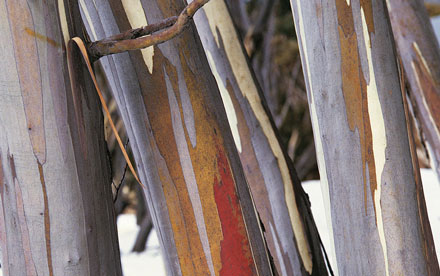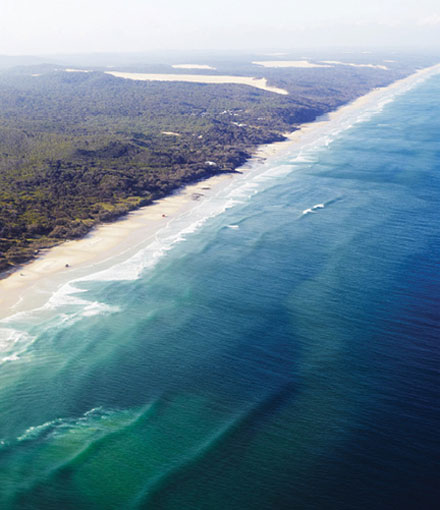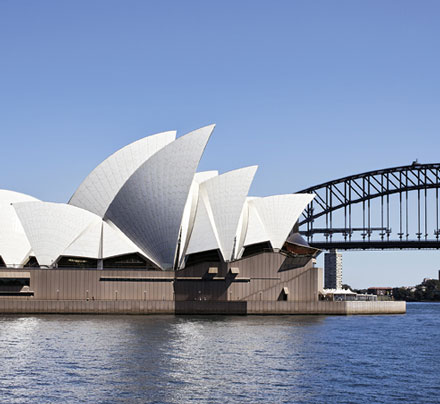Australia has around 10 per cent of the world's biodiversity and is one of the 17 megadiverse countries that together account for almost 70 per cent of the world's species. It is a land like no other.
 Snow gums in Mount Buller (Tourism Australia)
Snow gums in Mount Buller (Tourism Australia)
More than 80 per cent of Australia's mammals, reptiles, frogs and flowering plants are unique to Australia, along with many of its freshwater fish and almost half its birds. There are more than 140 species of marsupials (animals that carry their young in a pouch) such as kangaroos, koalas, wombats and the Tasmanian Devil. Australia is also home to two monotremes, the platypus and the echidna. These egg-laying mammals are so unusual that they are sometimes referred to as 'living fossils'.
Australia's national reserve system covers 16.5 per cent of Australia's land mass—more than 127 million hectares (313 million acres) across 10,000 properties—and includes a range of habitats from lush rainforests to savannas and deserts. The Commonwealth marine reserve estate, with 60 reserves, including the Great Barrier Reef Marine Park, covers 3.1 million square kilometres, approximately one third of Commonwealth waters.
 Great Ocean Road, Victoria (Chris Kapa, Tourism Australia)
Great Ocean Road, Victoria (Chris Kapa, Tourism Australia)
A Leading Antarctic Nation
Australia is a leading Antarctic nation, driving international efforts to preserve Antarctica as a natural reserve devoted to peace and science. About 80 scientists and support staff live and work on Australia's Antarctic stations during winter and as many as 200 in the summer months. Marine scientists also work on Australian research vessels in the Southern Ocean. Australia's world-class Antarctic research program contributes to understanding environmental systems in Antarctica and the effects of global climate change. It involves cooperation with hundreds of institutions in more than 25 countries.
19 Australian sites are listed on the UNESCO World Heritage List.
Great Barrier Reef
One of Australia’s most iconic World Heritage sites is the Great Barrier Reef. The Reef was inscribed on the World Heritage List in 1981 and is one of the best managed marine areas in the world. Spanning 348,000 square kilometres, it is a maze of some 3,000 coral reefs and around 1,050 islands. Australia protects the Great Barrier Reef through a number of government bodies including the Department of Environment and the Great Barrier Reef Marine Park Authority. The Australian and Queensland governments are jointly investing a projected $2 billion over the next decade in the Reef’s health.
Australia’s actions to protect the Reef
In its last four sessions, UNESCO’s World Heritage Committee (WHC) has considered the state of conservation of the Great Barrier Reef World Heritage Area. The WHC requested a series of measures be undertaken to ensure that the Outstanding Universal Value of the property is not compromised to which Australia has responded to. Details of their decision can be found on the Department of Environment’s website.
Australia’s Reef 2050 Long-Term Sustainability Plan, additional recently-announced funding to protect the Reef and the progress Australia has made to in responding to World Heritage Committee concerns demonstrates the unprecedented action taken by the Australian and Queensland governments to ensure that the Great Barrier Reef remains healthy for decades to come.
Link: What Australia is doing to manage the Great Barrier Reef
UNESCO
The United Nations Educational Scientific and Cultural Organisation (UNESCO) is a specialised agency of the United Nations which implements its activities through the five program areas of education, natural sciences, social and human sciences, culture, and communication and information. Through the WHC, UNESCO manages the listing of World Heritage sites across the globe, including Australia’s 19 listed properties.
World Heritage sites are places that are important to and belong to everyone, irrespective of where they are located. To find out more information about Australia’s World Heritage sites, please visit the Department of Environment’s website.
 Tasmanian Wilderness—one of the three largest temperate wilderness areas remaining in the Southern Hemisphere (Graham Freeman, Tourism Australia)
Tasmanian Wilderness—one of the three largest temperate wilderness areas remaining in the Southern Hemisphere (Graham Freeman, Tourism Australia)
 Great Barrier Reef, Queensland— the world's largest coral reef system (D. Bergmark, Tourism Australia)
Great Barrier Reef, Queensland— the world's largest coral reef system (D. Bergmark, Tourism Australia)
 Shark Bay, Western Australia—2.2 million hectares of unspoilt coastal landscape (Anson Smart, Tourism Australia)
Shark Bay, Western Australia—2.2 million hectares of unspoilt coastal landscape (Anson Smart, Tourism Australia)
 Australian fossil mammal site, Naracoorte, South Australia—some of the richest fossil deposits in the world (SA Department of Environment, Water and Natural Resources)
Australian fossil mammal site, Naracoorte, South Australia—some of the richest fossil deposits in the world (SA Department of Environment, Water and Natural Resources)
 Fraser Island, Queensland— the world's largest sand island (Maxime Coquard, Tourism Australia)
Fraser Island, Queensland— the world's largest sand island (Maxime Coquard, Tourism Australia)
 Royal Exhibition Building, Victoria— one of the last remaining world fair buildings which is still used for exhibitions (Tourism Victoria)
Royal Exhibition Building, Victoria— one of the last remaining world fair buildings which is still used for exhibitions (Tourism Victoria)
 Sydney Opera House— an internationally significant building (Camille Nuttall, Tourism Australia)
Sydney Opera House— an internationally significant building (Camille Nuttall, Tourism Australia)
 Uluru–Kata Tjuta National Park, Northern Territory— a culturally sacred landscape for Aboriginal people (Masaru Kitano snaK Productions, Tourism Australia)
Uluru–Kata Tjuta National Park, Northern Territory— a culturally sacred landscape for Aboriginal people (Masaru Kitano snaK Productions, Tourism Australia)